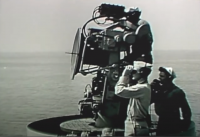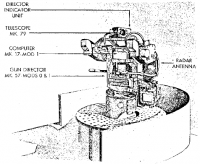Mk 57 GFCS
The Mark 57 gun fire control system was a wartime blind-fire director fitted to USN cruisers, battleships, and aircraft carriers. Development began in early 1943 based on an urgent fleet requirement for a lightweight anti-aircraft director capable of blind-fire. Mark 57 re-used many features of the Mark 52 director already in service. The operator moved the director pedestal manually tracking the target by "undisturbed line-of-sight". After development and "brief tests", 450 Mark 57 directors were ordered in March 1944. The prototype was tested aboard USS Wyoming and the first operational units fitted aboard USS Missouri, USS Alaska, and USS Guam - all in time for the Okinawa operation. Generally, four directors were allocated for a large surface combatant with one covering each quadrant. Mark 57 could direct 40mm Bofors or 5" guns.
The visible above-deck component of this director is the director pedestal itself (it required a below-decks radar room); the gun director itself consisted of the director indicator unit, Telescope Mark 79 Mod.0, Computer Mark 17 Mod.1, Gun Director Mark 57 Mods 0 or 1, and the radar antenna. Radar equipment usually associated with the Mark 57 was the Mark 29 (30" conically-scanned X-band dish), or the later Mark 34 (for Mark 57 Mods 3 & 4). Radar Mark 34 included an additional spiral scan target acquisition mode (and a Target Acquisition Unit in the radar room). This allowed targets designated by the larger search radars to be acquired more quickly.
Crew requirement varied by ship and operational procedure, but a postwar training video shows a control officer (who supervised operation of the director and training of the crew), a director pointer (who aimed the director and tracked the target in bearing and elevation), and one or more talkers (to relay orders). Shipboard installations were mounted high up on the superstructure with a 3' tall #15 STS splinter shield surrounding the base of the pedestal. The pointer stood on a perforated steel platform roughly even with the surrounding splinter shield and pointed/trained the director manually, sighting the target either through open sights or the Mark 79 Mod.0 telescope.
Mark 57 and Mark 63 were the only blind-firing machine gun directors available during the war.
See also
- Ordnance Pamphlets:
- OP 1323, Gun Fire Control System Mk 57 Mod 1
- OP 1323A, Gun Fire Control System Mk 57, Maintenance (Less Radar Equipment) - 25 Jul 45
- OP 1323B, Gun Fire Control System Mk 57, Installation, Maintenance and Accuracy Tests (Preliminary) - 31 Oct 45
- OP 1323C, Gun Fire Control System Mk 57, Schematic Diagrams (Preliminary) - 31 Aug 45
References
- Friedman, N. (2014). Naval Anti-Aircraft Guns and Gunnery (Illustrated ed.). Naval Institute Press.

